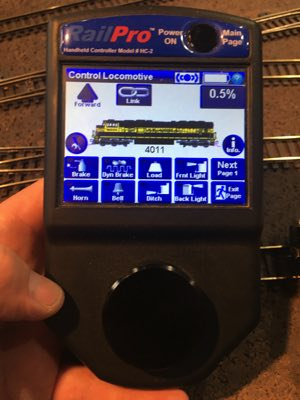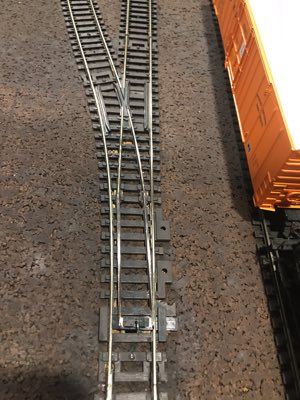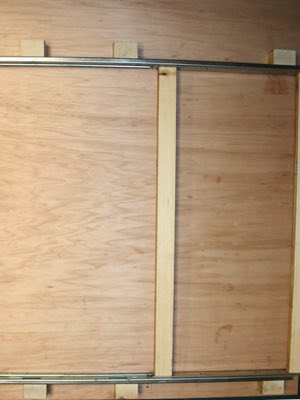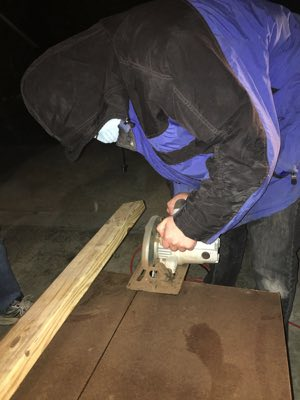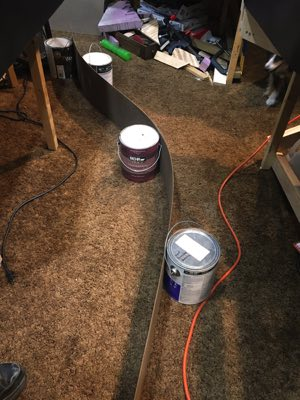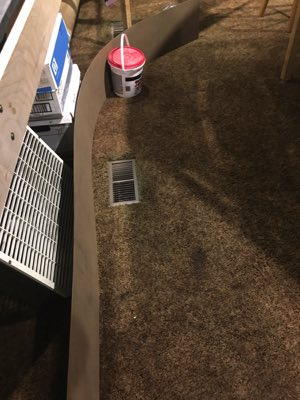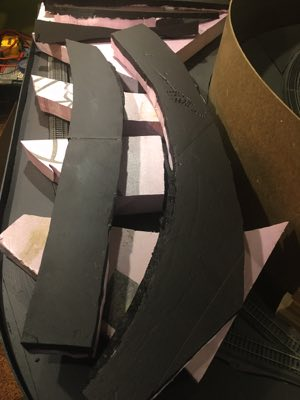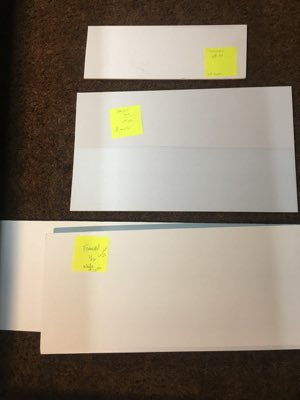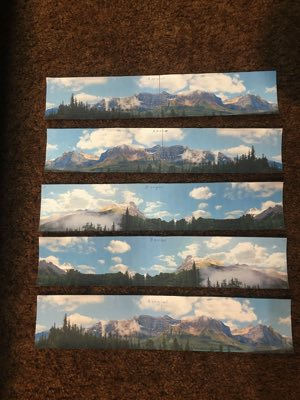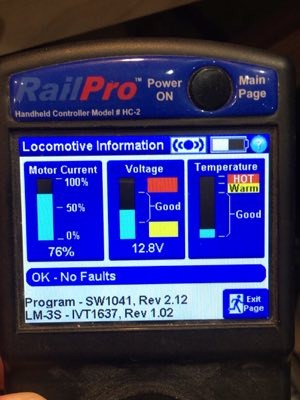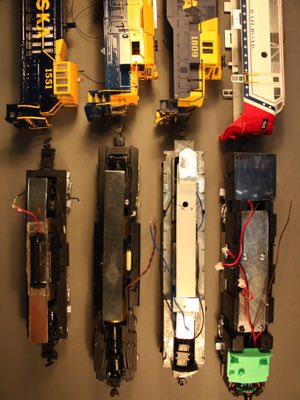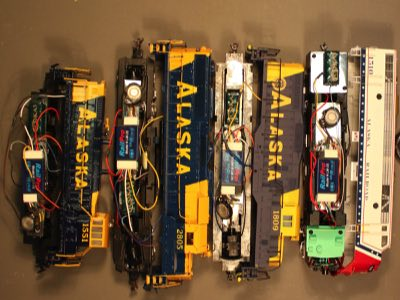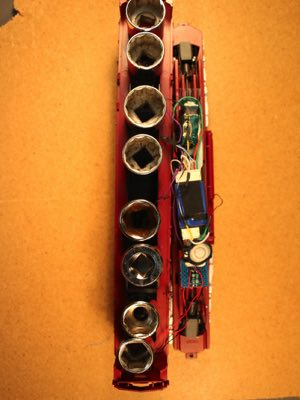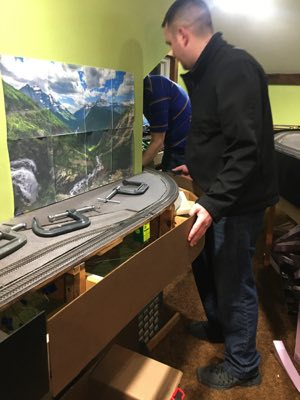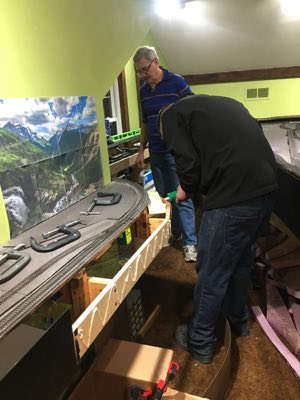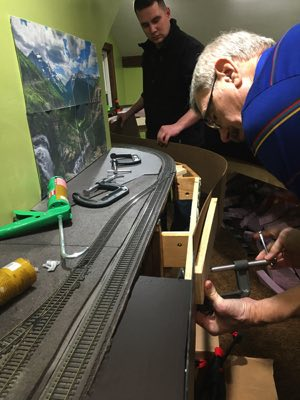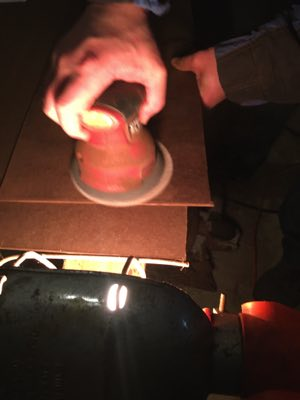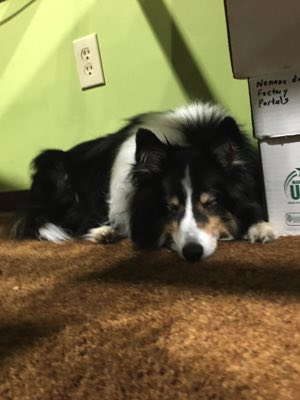January 1, 2020
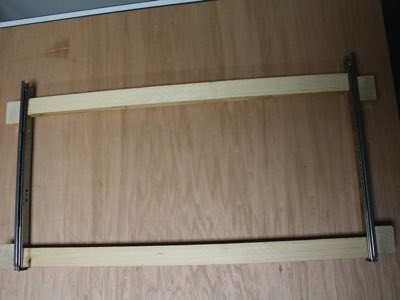 |
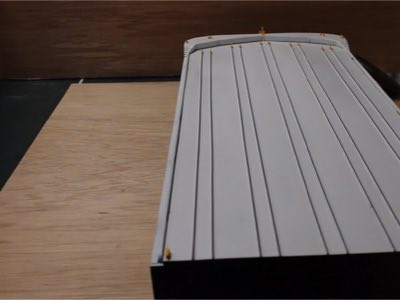 |
|
| Rick continues to work on the Whittier barge transfer table. The above photo shows the assembled transfer table sliding mechanism. With the mechanical system complete Rick will now hunt for a suitable motor and supporting electrical system. |
This brief video shows Rick lightly nudging the barge atop the transfer table. The barge slides easily along the table's rail system. |
John explored the possibility of purchasing a professionally printed backdrop for the north, east and south walls. Would a 24-inch tall backdrop seem disproportionate for narrow sections of track? John found an online digital mountain scene and used Rasterbator to print out multiple pages to create a 22" x 34" poster. He then mounted it to narrowest section of the layout and conducted a poll. So far, the verdict is a unanimous "yes!'. Digital Fringe has agreed to mount the images to fiber board while brother-in-law Ted volunteered to attach them to the wall using clips so they can be removed to facilitate opening of the windows. |
|
|
 |
| John created custom Alaska Railroad icons for each RailPro locomotive and Rick spent part of the evening downloading them from his laptop to the handheld controllers. |
While working with the transfer of the icons Rick discovered a switch causing derailments. Considerable time was spent filing parts of the switch to minimize the problem. |
The above photo is a current panoramic view of the layout. |
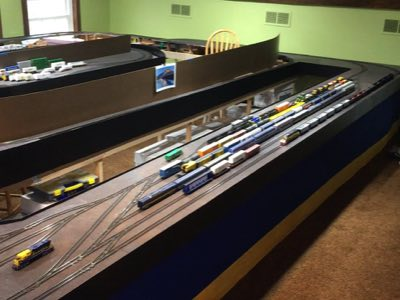 |
 |
 |
| This video shows an SD70MAC pulling a coal train through the Anchorage yard, across the swing gate, past the Port of Whittier and into the dreaded "S" curve. |
This video shows a "railfan" view of a passing coal train. |
Rick will soon begin converting the final four locomotives (GP49, GP7, MP15 and bicentennial F7) to RailPro bringing the total count to 24! |
January 8, 2020
|
|
|
| Whittier barge transfer table - Rails mounted to wooden base. Moved to far left. |
Whittier barge transfer table - Moved to far right. |
LJ cuts the fiber board with a circular saw while Rick helps to support the wood. The first cut will create fascia for the dreaded "S" curve. The second cut came from a new 4'x8' fiber board that Rick and John picked up several days prior. This fascia board will be used at Usibelli Coal Mine (UCM). |
|
|
|
| LJ and Rick put the S curve fascia board on the floor and place paint cans at the bends. Over the next couple of days John will spray the boards with water and move the paint cans to increase the bend. |
LJ and Rick out the UCM board on the floor and place cans/buckets at the bend locations. Again, John will spray and bend the board to ready it for final placement. |
Paul the Painter is back tonight and his canvas is three foam board sections at the Port of Whittier and one near Alaska Marine Lines. Scrap foam board is used as the drying rack for these pieces. |
|
|
|
| Brother-n-law Ted investigates the type of board to use for the wall backdrop. Gator Board (at top) is the best quality material being lightweight with high structural integrity and resistant to water, scratches, and dents. It is also very expensive! Coroplast (middle) is very inexpensive, ultra lightweight, and is also resistant to the elements. However, it warps easily and its surface has has a venetian blind texture which MIGHT comes through the printed backdrop. The best choice is Foam Board (at bottom) which is moderately priced, lightweight. It is prone to denting and scratching. Digital Fringe will mount the images to the Foam Board. |
AJM Railways sells the backdrops which are shot by a Professional Photographer and are printed on high quality light resistant self adhesive poly paper. The backdrop is 2'x10' and a second side-by-side print will provide a 2'x20' backdrop. As I need 51 feet of backdrop AJM Railways will print mirror images for me in a "A original + B original + B mirror + A mirror + A original " format. The additional 1 foot panel is provided free of charge. I did a screen shot of their backdrops and printed them out to ensure I understood the mirroring and side-by-side concept. |
Placing these printed images end-to-end confirms the proposed solution will indeed work. Once the backdrops are mounted on the Foam Board Ted will mount the images to the wall. The requirement dictates windows on the north and east wall must be accessible for opening. The backdrops on these walls must be removable thus the importance of ultra lightweight and durable board. The south wall has three cold air returns so removable panels for these will be created. As a final note, all inward corners will be cut to match while the outward corner will wrap around. Needless to say, this will be an intense installation. |
January 15, 2020
|
|
|
| The RailPro system has many amazing advantages such as on screen status windows. This video shows how a locomotive's status can be monitored in regards to motor current, voltage and the temperature of the RailPro module itself. |
Rick is working on the conversion of the final four locomotives to RailPro. The GP7 took him 1.5 hours to convert which included modifying the sheet metal along the body plus trimming a section at the end to serve as a shelf for the iPhone 4 speaker. |
The shells for each of the four locomotives were removed and are ready for parts. |
|
|
|
| All four locomotives shown after installation of the RailPro LM-3S module, Keep-Alive and iPhone 4S speaker. The bicentennial unit's installation was a breeze which #1809 took about four hours. No. 2805 required a special effort of gluing the LED to the lens while no. 1551 was a tight squeeze and required extra effort getting the wires above the internal shelf. |
No. 7002 is in the shop for a special effort to glue the walkway to the shell. The sockets are holding the two pieces together during the 1.5 day drying period. |
There is a lot of excitement in the air as the fascia effort begins to draw to a close. When the S curve fascia is removed from the "paint can bending setup" it almost perfectly fits the bench work. |
|
|
|
| LJ applies Liquid Nails to the bench work. |
Next, Rick and LJ apply clamps to the fascia. |
Final adjustments are made so the fascia board is half an inch higher than the road bed. |
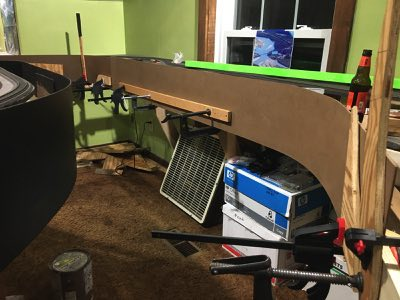 |
 |
|
| Standing at the south end of the S curve fascia board looking north. |
Standing at the middle of the S curve fascia board looking north. |
It is very exciting cutting the last of the required fascia boards. John holds the light while LJ cuts the eight foot long fascia board with a circular saw. Rick provides support while Paul the Painter cracks jokes. |
|
|
|
| The last of the fascia boards are hit with a palm sander which removes the slick finish in preparation for painting. |
The fascia board is mounted along the double track. Some creative clamping was required to hold it in place. One last piece of fascia board is on the floor for bending. Next week it will be mounted and all installation will be complete! |
Max, our Project Supervisor, is worn out by the evening's efforts. Tonight's dinner was bratwurst so he may be dreaming of these mouth watering hot dogs! |
January 22, 2020
 |
 |
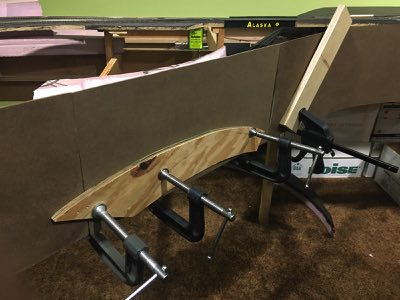 |
| A huge milestone is reached tonight as the last two pieces of fascia are put into place. |
LJ and Rick remove the Flint Hills fascia board from the floor and use Liquid Nails and clamps to put it into place. The board was bent over the prior week and was the exact shape needed for the existing L-girder bench work. |
LJ cut fascia board the exact length to fill the gap between Flint Hills and the double track. Liquid Nails and clamps secure it in place. |
 |
 |
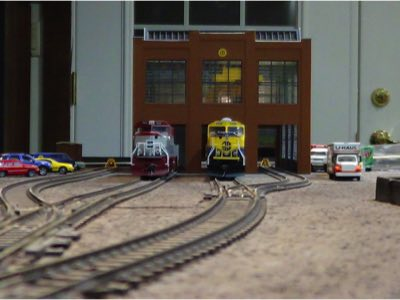 |
| A small section of fascia at the top of the double track is too high so Rick uses a hand saw to remove the excess. A sanding block smooths the top edge in preparation for painting. |
John strengthens the joints between fascia boards with small sections of fiber board. Liquid Nails and clamps hold it in place. Once the sections have dried spackling and sanding will take place. |
No sections of foam board required painting tonight so Paul the Painter spent part of his time using his camcorder to take photos of the layout. Here is one of the front of the diesel shop. |
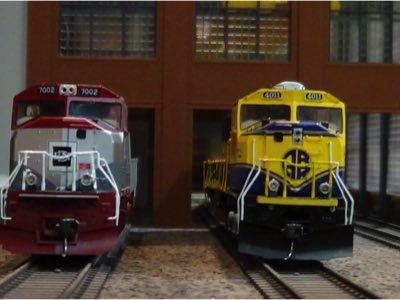 |
 |
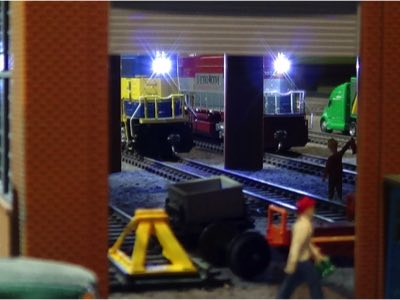 |
| Close up of SD70MACs at the diesel shop. |
A view from the rear of the diesel shop. |
Paul asks if I have any props for the photo. Cars, carts and a few people later and... tada! |
 |
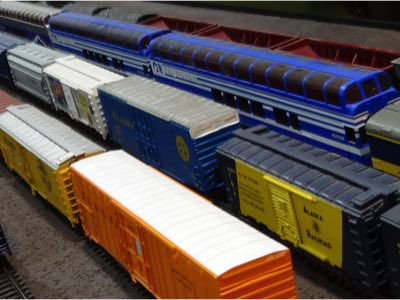 |
 |
| A line of power standing by waiting for work. |
A hang glider's view of the Anchorage yard. |
A row of cabooses waiting to be paired up with a gravel train. |
January 29, 2020
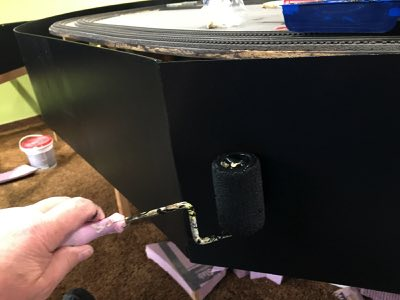 |
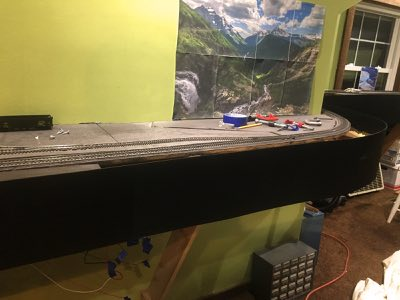 |
 |
| Over the past week I've been working on painting although I pretty much suck at it. At times I can be a real perfectionist so even the slightest streaks drive me crazy. I must say over the past few years I've learned not to take myself so seriously. Good enough for who its for. |
Spackle and sand, spackle and sand. Now the joints have feathered in well I can begin to paint. Here is the first coat of paint south of the Port of Whittier leading into the dreaded "S" curve. |
Here's the first coat of black paint on the fascia at Usibelli Coal Mine. The 100 watt stereo system is blaring out Blues Traveler's "Hook" and I resist the urge to jump onto the top of the table and bust a move. If I had I would have spilled the paint tray everywhere. |
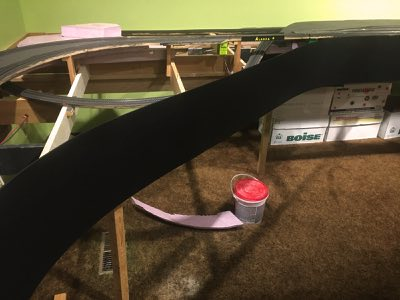 |
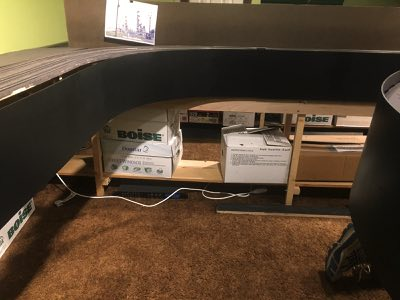 |
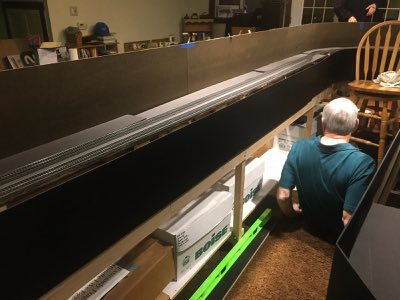 |
| Continuing south I slather on the first coat of paint at Mountain subdivision. iHeart Radio blast out the the word of the hour and I text it in hoping to win $1,000 towards the layout. Nope. |
Heading west the painting continues as AC/DC belts out "Thunderstruck". Whenever I relocate around the layout Max follows like a shadow. He readily admits to being more of fan of the acoustic piano then classic rock. |
Tonight the crew (minus John) is in full swing. Rick does some wiring checks plus re-installs a repaired AM-1 (controls a set of four switches). |
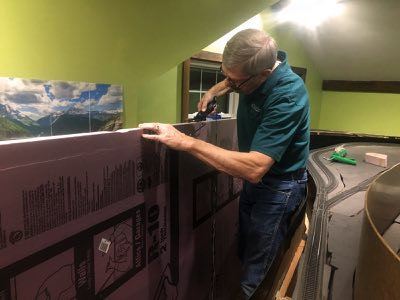 |
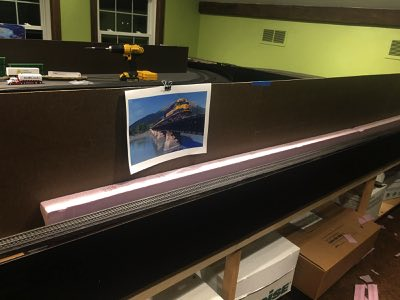 |
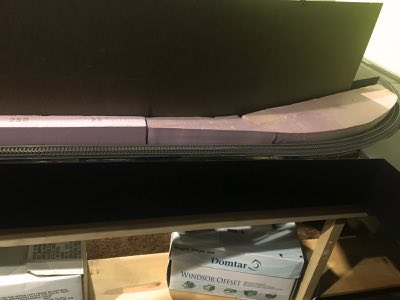 |
| With all fascia installed attention turns to foam board placement. Rick brings a 4'x8' sheet of foam board up from the garage (via the outside balcony) and carves a slice out using the hot wire tool. |
After lots of fine tune carving Ricks gets the slice to fit in at TwentyMile Bridge. |
Before the evening is over Rick fills in the south end with foam board all the way to the existing sections at the refinery. |







